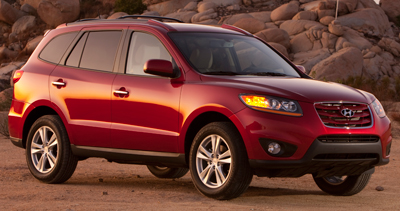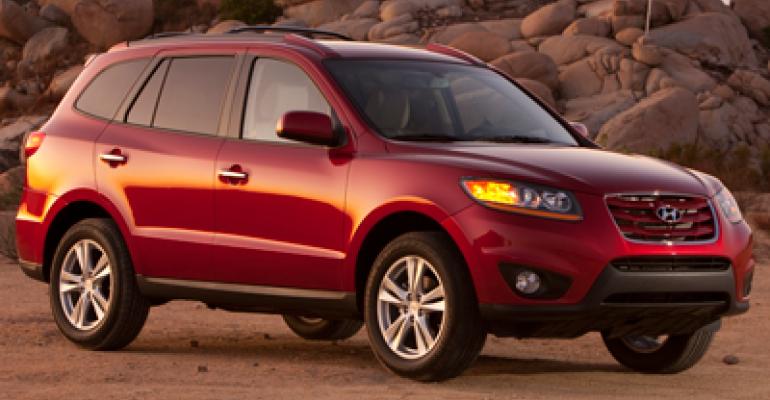
PORTLAND, OR – Hyundai Motor America’s sales success in the last two years largely has been due to the growth in its car lineup, and the South Korean brand now is focusing on getting its cross/utility vehicles on track.
“We could do better,” CEO John Krafcik tells WardsAuto during a Veloster media event here. “If you look at the passenger-car side of the industry, we’re over 7% (market share).
If you look at the crossover/truck side of the industry, we’re about 2.5%. We are very under-represented in terms of (CUV) sales.”
WardsAuto data on the Middle CUV segment, one of the industry’s fastest-growing and most-competitive groups, shows the Hyundai Santa Fe held a 2.2% share through the year’s second quarter, down from 3.3% year-ago. That trails the Ford Escape (7.9%), sister-brand Kia’s Sorento (4.0%) and Subaru Forester (2.4%).
The current Santa Fe is nearing the end of its lifecycle, with a next-generation set for a mid-2012 debut, Krafcik says. However, he blames the CUV’s underperformance on a production shortage more than its age. “We’ve had a major capacity constraint on Santa Fe,” he says.
The Santa Fe had 33 days’ supply at the end of August, compared with 40 days’ in July and 32 year-ago. Fifty-six days’ supply was average for U.S. light trucks in late August.
Originally coming out of Hyundai’s Montgomery, AL, plant, Santa Fe output was shifted last year to Kia’s West Point, GA, factory. Krafcik says it’s “too early to say” whether that setup will continue with the new Santa Fe, which he says will resemble the “fluidic sculpture” style of the Tucson.
“We never used to have a strong family look, and now we do,” he says.

“And I think we’ve done it in a way that is not like a sausage machine, with sausages of different lengths. The Veloster (new sport coupe) looks unique.
But you could say (it) could only be a Hyundai – same with the (next-generation) Azera. I think when you’ll see the new Santa Fe, you’ll say the same thing.”
With sales down 9.4% through August, the Santa Fe is the only Hyundai CUV lagging its 2010 volume. However, the recently redone Tucson is not seeing the sharp sales increases from the former-generation to the new model that the brand’s passenger cars are enjoying.
Tucson sales grew 16.6% in the year’s first eight months, well below the Elantra’s 46.8% increase, for instance.
Hyundai’s large Veracruz CUV, launched in 2007, has long been rumored to be on the chopping block, but Krafcik says another generation is in the works. “(The) Veracruz (is) doing well. The numbers don’t look like a lot, but again it’s a car we don’t have a lot of production availability on.”
The Veracruz had an 89 days’ supply in late August, WardsAuto data shows. Sales were up 18.1% through August, to 6,019 units.
The auto maker’s small, medium and large 3-CUV strategy is optimal for Hyundai to grow its presence with families, without having to resort to a new entrant or a minivan, Krafcik says.
“When you look at the area where we could grow our sales…it’s families of four or more people,” he says of a weak demographic point for the brand.
But the numbers aren’t there right now for Hyundai to reenter the minivan segment, which it abandoned after the ’07-’09 Entourage.
“Maybe it’s a 400,000-unit retail segment,” Krafcik estimates of U.S. non-fleet minivan sales.
“We’re a 5%-6% share brand. But if we’re going to enter a new segment like that one, we might target 10%. We have a few products that do more than 10% segment share, (the) Sonata and Elantra in particular.
“Let’s say we set that target at 10%,” he adds. “That’s 40,000 vehicles, probably not quite enough to justify doing a minivan.”
In comparison, the four top-selling minivans last year were the Chrysler Town & Country, Dodge Caravan, Honda Odyssey and Toyota Sienna – each with sales of about 100,000 units.
Other entrants in the segment in 2010, the Kia Sedona, Nissan Quest and Volkswagen Routan, sold considerably less, with the Sedona’s 21,823 units leading the pack.




